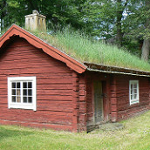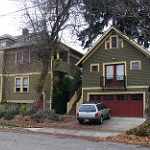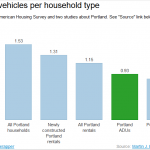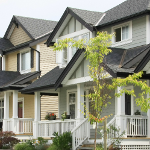Homes are both the emotional center of human lives, and a giant source of environmental impacts. How can housing lighten up on the Earth, while improving quality of life for the people living in it?
Currently I study two parts of the housing market that show a lot of promise, but deserve a cool analytical eye:

|

“Green” certified housing such as LEED, Energy Star, etc. |
Research on Accessory Dwelling Units.
Accessory dwelling units, also known as “granny flats,” “ADUs,” and a dozen other monikers, are small secondary dwellings associated with a standard single family houses. Their small size should make them inherently “green,” and there are hopes they will provide social benefits as well. However, citizens and cities sometimes fear allowing ADUs will have adverse effects on quality of life.
I found that separating the hopes and fears about ADUs from the reality was difficult because of dearth of data. I took it on myself to start building data sets and analyzing them formally.
 Case studies. I am co-founder and co-editor of accessorydwellings.org, a web site whose primary content is a large collection of case studies of real ADUs and their owners. These case studies provide a foundation for understanding how and why real ADUs are created. Case studies. I am co-founder and co-editor of accessorydwellings.org, a web site whose primary content is a large collection of case studies of real ADUs and their owners. These case studies provide a foundation for understanding how and why real ADUs are created. |
 Economic valuation. With support from The Appraisers Research Foundation, I lead-authored the first economic evaluation of accessory dwelling units. This was the first peer-reviewed paper with original data on ADUs to be published in more than a decade. Appraisal Journal. Economic valuation. With support from The Appraisers Research Foundation, I lead-authored the first economic evaluation of accessory dwelling units. This was the first peer-reviewed paper with original data on ADUs to be published in more than a decade. Appraisal Journal. |
 Social and environmental impacts. With support from the Oregon DEQ, I authored the only existing data-driven analysis of the social and environmental impacts of ADUs. Read the report for the DEQ, and the expanded series of analyses on accessorydwellings.org (summarized here). Social and environmental impacts. With support from the Oregon DEQ, I authored the only existing data-driven analysis of the social and environmental impacts of ADUs. Read the report for the DEQ, and the expanded series of analyses on accessorydwellings.org (summarized here). |
Green certified homes
Voluntary green certifications, such as LEED, are a popular way of establishing environmental credentials for buildings. However, the actual environmental value of certifications can be questioned. Way back in 2006, I wrote a piece for E: the Environmental Magazine where I was surprised to discover that, at the time anyway, “green” certified homes could be real gas guzzlers.
Since then I’ve investigated certified homes more formally.
 I’ved worked as statistician on numerous projects designed to assess their financial “premium” associated with certification, for example this one from Earth Advantage and NEEA. |
 With support from The Appraisers Research Foundation, I studied the key practical question: Are certified homes a cost-effective way to aid the environment? I combined a meta-analysis of the premium worldwide with a local examination of environmental benefits. Read the pre-publication MS. With support from The Appraisers Research Foundation, I studied the key practical question: Are certified homes a cost-effective way to aid the environment? I combined a meta-analysis of the premium worldwide with a local examination of environmental benefits. Read the pre-publication MS. |